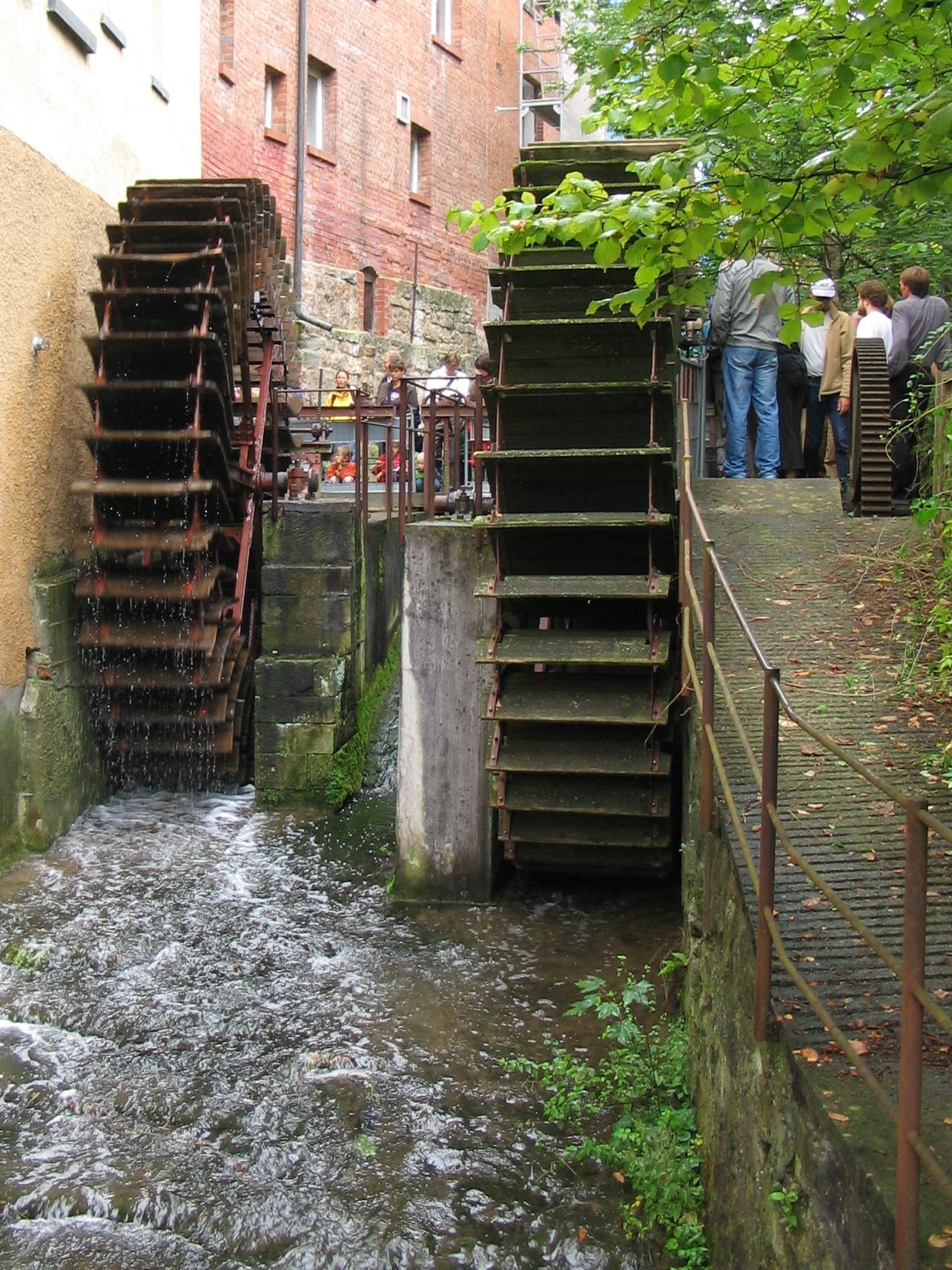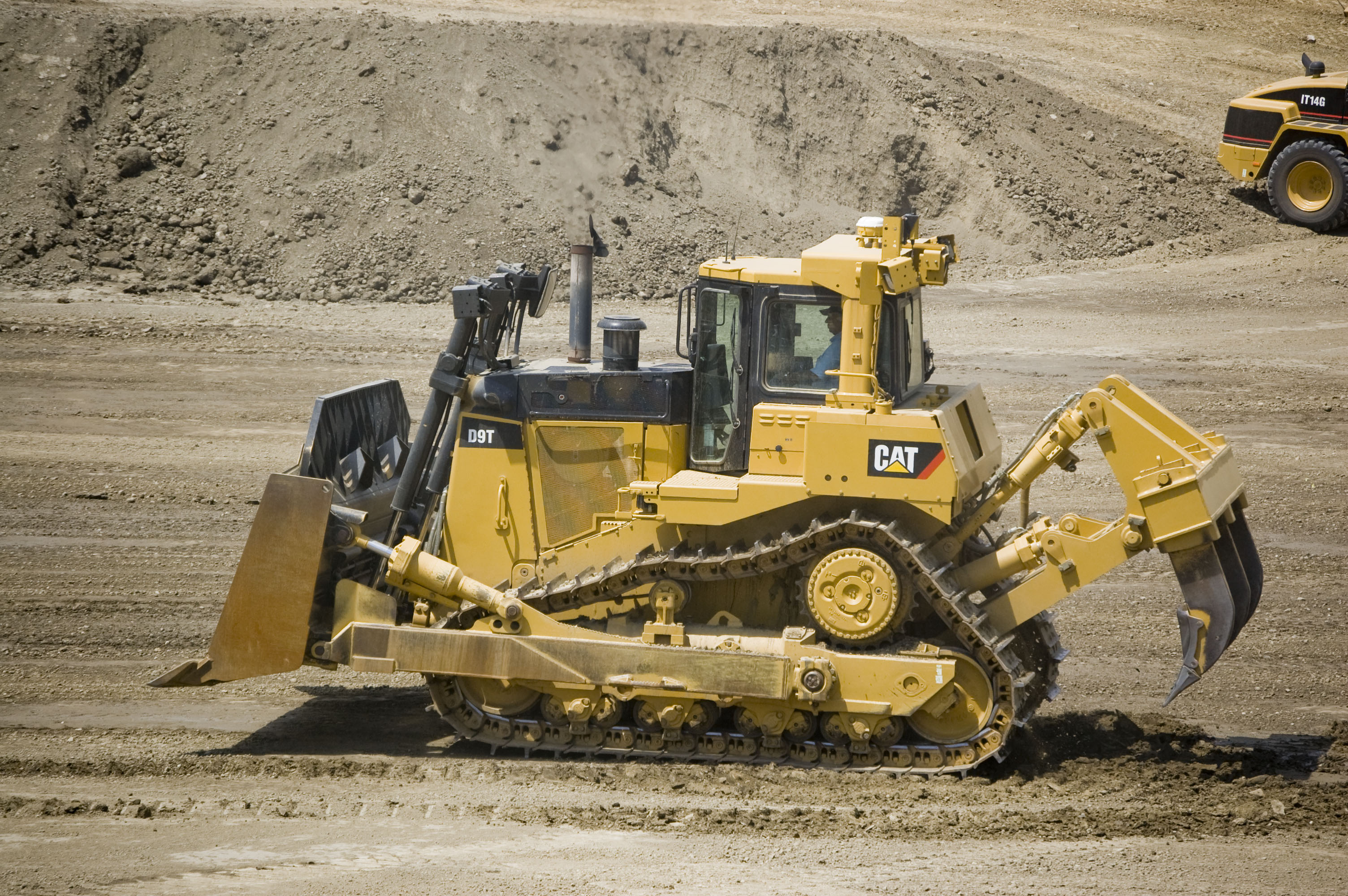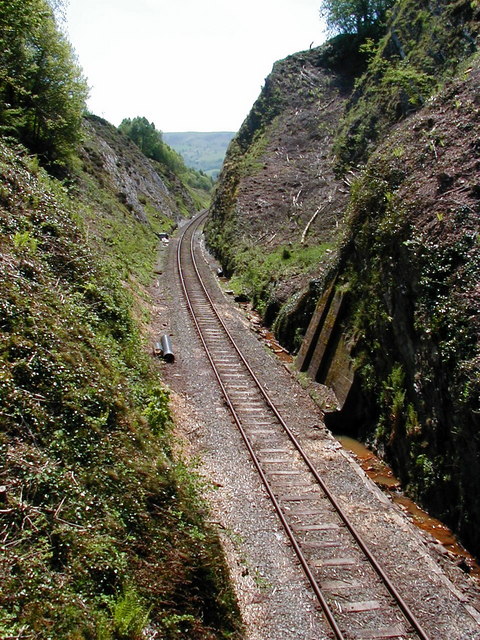|
Wheel Tractor-scraper
In civil engineering, a wheel tractor-scraper (also known as a land scraper, land leveler, tournapull or simply called a scraper) is a type of heavy equipment used for earthmoving. It has a pan/hopper for loading and carrying material. The pan has a tapered horizontal front cutting edge that cuts into the soil like a carpenter's plane or cheese slicer and fills the hopper which has a movable ejection system. The horsepower of the machine, depth of the cut, type of material, and slope of the cut area affect how quickly the pan is filled. When full, the pan is raised, the apron is closed, and the scraper transports its load to the fill area. There the pan height is set and the lip is opened (the lip is what the bottom edge of the apron is called), so that the ejection system can be engaged for dumping the load. The forward momentum or speed of the machine affects how big an area is covered with the load. A high pan height and slow speed will dump the load over a short dista ... [...More Info...] [...Related Items...] OR: [Wikipedia] [Google] [Baidu] |
Hydraulics
Hydraulics () is a technology and applied science using engineering, chemistry, and other sciences involving the mechanical properties and use of liquids. At a very basic level, hydraulics is the liquid counterpart of pneumatics, which concerns gases. Fluid mechanics provides the theoretical foundation for hydraulics, which focuses on applied engineering using the properties of fluids. In its fluid power applications, hydraulics is used for the generation, control, and transmission of Power (physics), power by the use of pressure, pressurized liquids. Hydraulic topics range through some parts of science and most of engineering modules, and they cover concepts such as pipe Volumetric flow rate, flow, dam design, fluidics, and fluid control circuitry. The principles of hydraulics are in use naturally in the human body within the vascular system and erectile tissue. ''Free surface hydraulics'' is the branch of hydraulics dealing with free surface flow, such as occurring in rivers ... [...More Info...] [...Related Items...] OR: [Wikipedia] [Google] [Baidu] |
Grader
A grader, also commonly referred to as a road grader, motor grader, or simply blade, is a form of heavy equipment with a long blade used to create a flat surface during Grading (engineering), grading. Although the earliest models were towed behind horses, and later tractors, most modern graders are self-propelled and thus technically "motor graders". Typical graders have three axles, with the steering wheels in front, followed by the grading blade or mouldboard, then a Cabin (truck), cab and engine atop tandem rear axles. Some graders also have front-wheel drives for improved performance. Some graders have optional rear attachments, such as a bulldozer#Ripper, ripper, scarifier, or compactor. A blade forward of the front axle may also be added. For snowplowing and some dirt grading operations, a main blade extension can also be mounted. Capacities range from a blade width of 2.50 to 7.30 m (8 to 24 ft) and engines from 93–373 kW (125–500 horsepower, hp). Certain gr ... [...More Info...] [...Related Items...] OR: [Wikipedia] [Google] [Baidu] |
Challenger Tractor With A Scraper Pan Behind
Challenger, Challengers, The Challenger, or, The Challengers, may refer to: Entertainment Comics and manga * Challenger (character), comic book character * ''Challengers'' (manga), manga by Hinako Takanaga Film and telemovies * ''Challengers'' (film), a 2024 romantic sports film directed by Luca Guadagnino * ''Challenger'' (1990 film), a television movie about the space shuttle ''Challenger'' disaster * ''The Challengers'' (film), a 1990 family film produced for the Canadian Broadcasting Corporation * ''The Challenger'', the original British title for the film ''The Challenger Disaster'', a 2013 BBC made-for-TV film * ''The Challenger'' (2015 film), an American sports drama film TV shows * ''The Challengers'' (TV series), a 1979–80 Canadian biographical television series * ''The Challengers'' (game show), a 1990 American game show hosted by Dick Clark * ''Challenger'' (1997 game show), an Australian game show * ''Challenger'' (2013 game show), a Pakistani game show ... [...More Info...] [...Related Items...] OR: [Wikipedia] [Google] [Baidu] |
Bulldozer
A bulldozer or dozer (also called a crawler) is a large tractor equipped with a metal #Blade, blade at the front for pushing material (soil, sand, snow, rubble, or rock) during construction work. It travels most commonly on continuous tracks, though specialized models riding on large Heavy equipment#Traction: Off-the-road tires and tracks, off-road tires are also produced. Its most popular accessory is a #Ripper, ripper, a large hook-like device mounted singly or in multiples in the rear to loosen dense materials. Bulldozers are used heavily in large and small scale construction, road building, mining and quarrying, on farms, in heavy industry factories, and in military applications in both peace and wartime. The word "bulldozer" refers only to a motorized unit fitted with a blade designed for pushing. The word is sometimes used inaccurately for other heavy equipment such as the generally similar Loader (equipment), front-end loader designed for carrying material rather than ... [...More Info...] [...Related Items...] OR: [Wikipedia] [Google] [Baidu] |
Cut And Fill
In earthmoving, cut and fill is the process of constructing a railway, road or canal whereby the amount of material from cuts roughly matches the amount of fill needed to make nearby embankments to minimize the amount of construction labor. Overview Cut sections of roadway or rail are areas where the roadway has a lower elevation than the surrounding terrain. Fill sections are elevated sections of a roadway or trackbed. Cut and fill takes material from cut excavations and uses this to make fill sections. It costs resources to excavate material, relocate it, and to compact and otherwise prepare the filled sections. The technique aims to minimise the effort of relocating excavated material while also taking into account other constraints such as maintaining a specified grade over the route. Other considerations In addition to minimising construction cost, other factors influence the placement of cut or filled sections. For example, air pollutants can concentrate in the val ... [...More Info...] [...Related Items...] OR: [Wikipedia] [Google] [Baidu] |
Conveyor Belt
A conveyor belt is the carrying medium of a belt conveyor system (often shortened to a belt conveyor). A belt conveyor system consists of two or more pulleys (sometimes referred to as drums), with a closed loop of carrying medium—the conveyor belt—that rotates about them. One or both of the pulleys are powered, moving the belt and the material on the belt forward. The powered pulley is called the drive pulley, while the unpowered pulley is called the idler pulley. There are two main industrial classes of belt conveyors; Those in general material handling such as those moving boxes along inside a factory and bulk material handling such as those used to transport large volumes of resources and agricultural materials, such as grain, salt, coal, ore, sand, overburden and more. Overview Conveyors are durable and reliable components used in automated distribution and warehousing, as well as manufacturing and production facilities. In combination with computer-controlled pallet ... [...More Info...] [...Related Items...] OR: [Wikipedia] [Google] [Baidu] |
Scraper
Scrape, scraper or scraping may refer to: Biology and medicine * Abrasion (medical), a type of injury * Scraper (biology), grazer-scraper, a water animal that feeds on stones and other substrates by grazing algae, microorganism and other matter * Scrape, a depression in the ground, bare of soil, which is used as a bird nest * Cloud scraper, birds of the genus ''Cisticola'' * scrapers, a group of cyprinid fish in the genus ''Capoeta'' Computing * Data scraping, a technique in which a computer program extracts data from human-readable output coming from another program ** Screen scraping, a method through which a program captures information from a display not intended for processing by computers ** Web scraping, extracting information from a website, for analysis or reuse, most effectively by a web crawler * Tracker scrape, request sent to a BitTorrent tracker ** Scraper site, a website created by web scraping ** Blog scraping, the process of scanning through a large number of ... [...More Info...] [...Related Items...] OR: [Wikipedia] [Google] [Baidu] |
Cut (earthmoving)
In civil engineering, a cut or cutting is where soil or rock from a relative rise is removed. Cuts are typically used in road, rail, and canal construction to reduce a route's length and grade. Cut and fill construction uses the spoils from cuts to fill in defiles to create straight routes at steady grades cost-effectively. Cuts are used as alternatives to indirect routes, embankments, or viaducts. They also have the advantage of comparatively lower noise pollution than elevated or at-grade solutions. In river management, the term cut or cutting is also used, which refers to the action of short-cutting a meander, in order to speed a waterway's flow. History The term ''cutting'' appears in the 19th century literature to designate rock cuts developed to moderate grades of railway lines. ''Railway Age's Comprehensive Railroad Dictionary'' defines a cut as "a passage cut for the roadway through an obstacle of rock or dirt." Creation Cuts can be created by multiple pa ... [...More Info...] [...Related Items...] OR: [Wikipedia] [Google] [Baidu] |
Clay
Clay is a type of fine-grained natural soil material containing clay minerals (hydrous aluminium phyllosilicates, e.g. kaolinite, ). Most pure clay minerals are white or light-coloured, but natural clays show a variety of colours from impurities, such as a reddish or brownish colour from small amounts of iron oxide. Clays develop plasticity (physics), plasticity when wet but can be hardened through Pottery#Firing, firing. Clay is the longest-known ceramic material. Prehistoric humans discovered the useful properties of clay and used it for making pottery. Some of the earliest pottery shards have been radiocarbon dating, dated to around 14,000 BCE, and Clay tablet, clay tablets were the first known writing medium. Clay is used in many modern industrial processes, such as paper making, cement production, and chemical filtration, filtering. Between one-half and two-thirds of the world's population live or work in buildings made with clay, often baked into brick, as an essenti ... [...More Info...] [...Related Items...] OR: [Wikipedia] [Google] [Baidu] |




